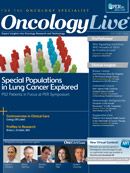Dual Pathways Must Be Targeted in ER-Positive Breast Cancer
Treating estrogen receptor–positive breast cancer without sparking resistance is a complex endeavor that should involve simultaneously targeting the hormone-signaling and PI3 kinase molecular pathways
Sarat Chandarlapaty, MD, PhD
Medical Oncologist
Assistant Member
Department of Medicine
Memorial Sloan-Kettering
Cancer Center
New York, NY
Treating estrogen receptor (ER)—positive breast cancer without sparking resistance is a complex endeavor that should involve simultaneously targeting the hormone-signaling and PI3 kinase (PI3K) molecular pathways1, according to Sarat Chandarlapaty, MD, PhD.
Chandarlapaty focused on how the two pathways cooperate in breast tumor progression, and discussed the development of combination treatments to target both channels during a presentation at the 11th International Congress on the Future of Breast Cancer, held in July in Coronado, California.
The PI3K/AKT/mTOR cascade is a nuclear pathway that is commonly activated in breast cancer, particularly in ER-positive disease. That and other pathways control normal cell physiology, such as growth, size, division, movement, and survival, but are frequently modified in ER-positive breast cancer, Chandarlapaty said.
In one study, PIK3CA mutations were found in 35% of ER-positive tumors versus 14% of ER-negative tumors,2 the doctor told his audience.
In addition, he said, alterations in the PI3K/AKT/mTOR pathway can take the form of HER2 amplification, loss of tumor suppressor PTEN, mutations in AKT, and other aberrations.
The result, Chandarlapaty said, is not only breast cancer, but also resistance to several endocrine therapies. And while in primary breast cancer patients with PIK3CA mutations tend to experience better overall survival than those with wild-type disease3, he said that advantage does not necessarily remain after the disease progresses or metastasizes.
Moreover, the doctor said, the ER and PI3K pathways are linked by their activation in breast cancer, and together correlate with resistance to endocrine-based treatments. When just one of the pathways is targeted with medication, the other becomes more active, and vice versa, Chandarlapaty said.
“This becomes something of a Whac-A-Mole,” he said, referring to the popular arcade game. “If you hit one pathway, you activate the other.”
Chandarlapaty and colleagues demonstrated such reciprocal feedback regulation between PI3K and the androgen receptor in PTEN-deficient mouse models of prostate cancer.4
Mutational Activation of PI3K/AKT/mTOR Pathway
BrCa indicates breast cancer.
Adapted from Chandarlapaty S. Nuclear hormone receptors and the PI3 kinase pathway. Presented at the11th International Congress on the Future of Breast Cancer; July 26-28, 2012; Coronado, CA.
Based on preclinical evidence, the doctor said, a similar pattern of reciprocal feedback seems to occur between the PI3K and ER pathways in ER-positive breast cancer. In one such study, researchers found that hyperactivation of PI3K predicts a poor response to adjuvant endocrine therapy in patients with the disease,5 Chandarlapaty explained.
One promising strategy has been a dual pathway approach. A randomized, placebo-controlled, phase II trial in postmenopausal women with operable ER-positive breast cancer found that everolimus (Afinitor), an mTORC1 inhibitor, increased the efficacy of letrozole (Femara), an aromatase inhibitor (AI) (P = 0.062),6 Chandarlapaty said.
In the phase III BOLERO-2 trial, everolimus plus exemestane (Aromasin) was found to improve progression-free survival in postmenopausal women with metastatic, hormone-refractory breast cancer compared with treatment with placebo plus exemestane (P <0.001).7 In July, the FDA approved that combination for the treatment of postmenopausal women with hormone receptor—positive, HER2-negative breast cancer after the failure of letrozole or anastrozole (Arimidex).
Since patients still progress on combination therapy, Chandarlapaty said, researchers must develop more, and better, strategies for targeting both pathways at once.
That process should involve conducting trials of more potent hormonal treatments and mTOR inhibitors, although that will carry the risk of more potent toxicities, the doctor suggested. He added that the development of drugs that target the PI3K pathway should address the various potential locations for inhibition there, as well as the identification of biomarkers that will guide patient selection by revealing when PI3K is driving resistance, and where along the pathway a mutation has occurred.
“There is a need to do these trials,” he said, “and determine if better drugging of the pathway will lead to better effects.”
References
- Chandarlapaty S. Negative feedback and adaptive resistance to the targeted therapy of cancer [published online ahead of print March 22, 2012]. Cancer Discov. 2012;2(4):311-319. doi: 10.1158/2159-8290.CD-12-0018.
- Saal LH, Holm K, Maurer M, et al. PIK3CA mutations correlate with hormone receptors, node metastasis, and ERBB2, and are mutually exclusive with PTEN loss in human breast carcinoma. Cancer Res. 2005;65(7):2554-2559.
- Kalinsky K, Jacks LM, Heguy A, et al. PIK3CA mutation associates with improved outcome in breast cancer [published online ahead of print August 11, 2009]. Clin Cancer Res. 2009;15(16):5049-5059. doi:10.1158/1078-0432.CCR-09-0632.
- Carver BS, Chapinski C, Wongvipat J, et al. Reciprocal feedback regulation of PI3K and androgen receptor signaling in PTEN-deficient prostate cancer. Cancer Cell. 2011;19(5):575-586.
- Miller TW, Hennessy BT, Gonzalez-Angulo AM, et al. Hyperactivation of phosphatidylinositol-3 kinase promotes escape from hormone dependence in estrogen receptor-positive human breast cancer [published online ahead of print June 7, 2010]. J Clin Invest. 2010;120(7):2406-2413. doi: 10:1172/JC141680.
- Baselga J, Semiglazov V, van Dam P, et al. Phase II randomized study of neoadjuvant everolimus plus letrozole compared with placebo plus letrozole in patients with estrogen receptor—positive breast cancer [published online ahead of print April 20, 2009]. J Clin Oncol. 2009;27(16): 2630-2637. doi: 10.1200/JCO.2008.18.8391.
- Baselga J, Campone M, Piccart M, et al. Everolimus in postmenopausal hormone-receptor-positive advanced breast cancer [published online ahead of print December 7, 2011]. N Engl J Med. 2012;366(6):520-529. doi:10.1056/NEJMoa1109653.




